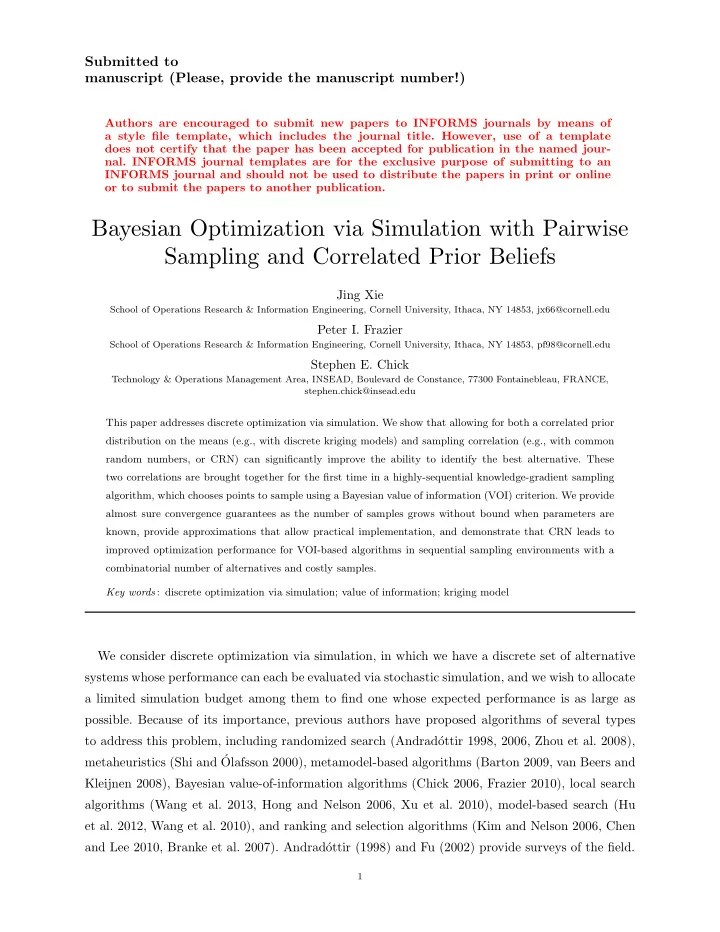

Submitted to manuscript (Please, provide the manuscript number!) Authors are encouraged to submit new papers to INFORMS journals by means of a style file template, which includes the journal title. However, use of a template does not certify that the paper has been accepted for publication in the named jour- nal. INFORMS journal templates are for the exclusive purpose of submitting to an INFORMS journal and should not be used to distribute the papers in print or online or to submit the papers to another publication. Bayesian Optimization via Simulation with Pairwise Sampling and Correlated Prior Beliefs Jing Xie School of Operations Research & Information Engineering, Cornell University, Ithaca, NY 14853, jx66@cornell.edu Peter I. Frazier School of Operations Research & Information Engineering, Cornell University, Ithaca, NY 14853, pf98@cornell.edu Stephen E. Chick Technology & Operations Management Area, INSEAD, Boulevard de Constance, 77300 Fontainebleau, FRANCE, stephen.chick@insead.edu This paper addresses discrete optimization via simulation. We show that allowing for both a correlated prior distribution on the means (e.g., with discrete kriging models) and sampling correlation (e.g., with common random numbers, or CRN) can significantly improve the ability to identify the best alternative. These two correlations are brought together for the first time in a highly-sequential knowledge-gradient sampling algorithm, which chooses points to sample using a Bayesian value of information (VOI) criterion. We provide almost sure convergence guarantees as the number of samples grows without bound when parameters are known, provide approximations that allow practical implementation, and demonstrate that CRN leads to improved optimization performance for VOI-based algorithms in sequential sampling environments with a combinatorial number of alternatives and costly samples. Key words : discrete optimization via simulation; value of information; kriging model We consider discrete optimization via simulation, in which we have a discrete set of alternative systems whose performance can each be evaluated via stochastic simulation, and we wish to allocate a limited simulation budget among them to find one whose expected performance is as large as possible. Because of its importance, previous authors have proposed algorithms of several types to address this problem, including randomized search (Andrad´ ottir 1998, 2006, Zhou et al. 2008), metaheuristics (Shi and ´ Olafsson 2000), metamodel-based algorithms (Barton 2009, van Beers and Kleijnen 2008), Bayesian value-of-information algorithms (Chick 2006, Frazier 2010), local search algorithms (Wang et al. 2013, Hong and Nelson 2006, Xu et al. 2010), model-based search (Hu et al. 2012, Wang et al. 2010), and ranking and selection algorithms (Kim and Nelson 2006, Chen and Lee 2010, Branke et al. 2007). Andrad´ ottir (1998) and Fu (2002) provide surveys of the field. 1
Xie, Frazier, and Chick: Bayesian Optimization via Simulation with Pairwise Sampling and Correlated Prior Beliefs 2 Article submitted to ; manuscript no. (Please, provide the manuscript number!) We study this problem in a Bayesian context, where we place a prior probability distribution on the values of the alternatives, and use value of information (VOI) calculations within a knowledge- gradient (KG) sampling algorithm to decide which alternative, or collection of alternatives, would be most useful to sample next. The advantage of doing so is that making decisions based on the VOI automatically addresses the exploration versus exploitation tradeoff, and tends to reduce the number of function evaluations required on average to reach a given solution quality, potentially (but not necessarily) at the cost of requiring more computation to decide where to sample. The prior probability distribution that we consider is a multivariate normal distribution, and allows for correlation in our prior belief between two alternatives. This models a belief that two alternatives with similar characteristics often have similar expected performance, and allows the algorithm that we construct to do well even in problems where the number of alternatives is much larger than the number of samples that we can take. We allow common random numbers (CRN), in which multiple alternatives are simulated using the same stream of random numbers. This induces correlation in the noise, which can be advanta- geous for optimization when the correlation is positive, because it allows more accurate estimation of the differences between alternatives’ values. Several previous authors have considered Bayesian formulations of optimization via simulation. The setting most frequently studied is that of ranking and selection, with relatively few alternatives, an independent prior distribution, and independent sampling (Gupta and Miescke 1996, Chick and Inoue 2001b, Frazier et al. 2008, Chick and Frazier 2012). Bayesian optimization via simulation with correlated prior distributions (but not with CRN) for problems with many alternatives was considered in a discrete setting (Frazier et al. 2009) and in a continuous setting (Villemonteix et al. 2009, Huang et al. 2006, Scott et al. 2011). This work in a continuous setting parallels work on noise-free Bayesian global optimization (Jones et al. 1998, Forrester et al. 2008, Brochu et al. 2009). Our analysis differs from this previous literature by allowing the use of CRN. This has been perceived to be difficult, because sampling with CRN makes it difficult to compute the VOI, and to maintain a closed-form posterior distribution. We overcome these difficulties by calculating the VOI for observing the difference in value between two alternatives, which can be done analytically, and by calculating the posterior with adaptively updated point estimates of the noise covariance. We show that, in the context of VOI-based algorithms, using CRN can greatly improve performance. Sampling with correlated means and CRN in the Bayesian setting using VOI methods has been considered by Chick and Inoue (2001a), but assumed two-stage sampling rather than fully sequential sampling, and restricted attention to conjugate prior distributions for the unknown means. Others have considered sampling with CRN in the optimal computing budget allocation framework (Fu et al. 2004), in the indifference-zone setting (Clark and Yang 1986, Nelson and
Recommend
More recommend